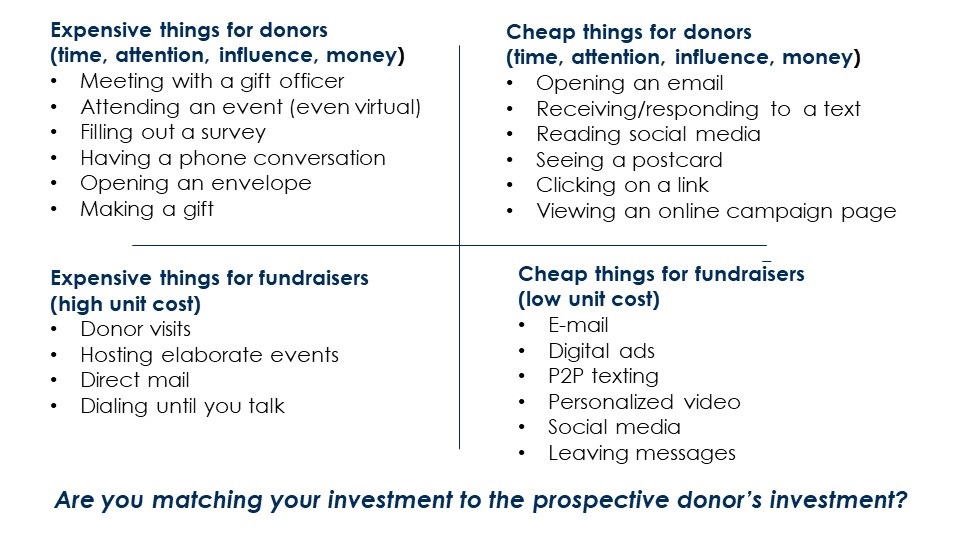fundraising
Three Ways to Find Budget for Fundraising Innovation, Even When Your Budget’s Getting Cut
In the first set of responses to our survey of advancement leaders, we found that a great majority of fundraisers expect budget and staff cuts in the coming year, while being expected to produce the same or greater results. Buckle up, advancement friends, it’s time once again for the types of resource crunches that cause us to think critically about how, why and at what cost we’re doing donor outreach.
I find these times energizing. This gives us an opportunity for us to counter the most dangerous phrase in fundraising: “we’ve always done it this way.” This type of resource crunch and the real need to engage donors to fill crucial needs gives us a pass to ruffle feathers, work as a team to find better solutions, and to innovate. In order to meet the goals in front of you, that innovation will be key.
And in order to do some new things, you’re going to have to spend. That’s a daunting idea at a time when budget and staff are being cut. But meeting new goals always requires new investment.
Talk with our fundraising experts
Let’s talk about how you can increase donor engagement and strengthen your donor pipeline. Ask for a free consultation with our experts.
Here are three direct, data-driven and immediately effective ways to make your budget cuts and free up additional funds to do new things.
Step 1: Cut the ineffective, annoying, and useless parts of your direct mail.
I was talking to a RNL partner recently about trying to find the funds to expand remote engagement by student engagement ambassadors. She said to me: “well, I could probably cut 20% of my direct mail with no impact.” This fundraiser, who is very smart, admitted that she sends several pieces of mail annually at response rates that are effectively zero, just to get the returned mail and update addresses. In order to again send the same zero response direct mail to “better addresses” the next year. When I hear about these things, I honestly question our sanity as fundraisers. The mail is annoying to donors, and while it does continue to establish that “the university is still fundraising,” it’s just a colossal waste of money.
(By the way, you can update addresses and get all kinds of great information on your constituents without sending them mail. Drop me a line and I’ll show you how).
Here’s an experiment to try. Sit down with your team, including your data team, and ask: “Who and what would we remove if we had to cut 25% of our direct mail expenditures?” Are there specific appeals and groups that offer categorically lower response rates? Are there ways to shift to lower cost pieces with online support components to some mid-range response groups? You might even consider taking the experience farther: what if you had to cut 50% of your direct mail? What would the impact be? You might find it to be very little in terms of donor response. Note that this requires working closely with your data team, not just guessing.
Direct mail is not dead. In fact, there are great ways to engage donors with the mail. I love “actionable postcards,” pieces that drive to a URL where the donor can engage, offer opinions, update information, or give. They’re colorful, don’t have to be opened, and come at a fraction of the postage and printing cost of envelopes. You can also send established donors neat, low cost stewardship pieces that have fun mobile phone stickers, magnets and other items that let them “live your brand.”
Step one is to remove low to no response groups. Step two is to move to lower cost (primarily digital) outreach to these groups. Combine this with lowering costs on your mid-range response groups. You could free up hundreds of thousands of dollars. You can use this money to meet budget constraints and try new things to build up these low response groups.
Step 2: Use prescriptive analytics to prioritize the best possible prospective donors to contact, right now.
Here’s how you try those new things. Most of us now utilize some form of predictive analytics, usually in the form of purchased or internally calculated propensity or engagement scoring. Every time I’ve surveyed fundraisers, their feelings about these scores are a collective “meh.” Sometimes these analytics are just bad. They’re mass produced, aren’t validated, or get stale very quickly. That’s why you want your predictive analytics to be customized to you, tested, and constantly changing as donors do new things.
The biggest reason these systems fail, however, is because fundraisers really don’t know what to do with them. If the definition of an appeal’s send group is “we send this to everyone,” then predictive analytics have no space to work. You should take quality predictive analytics and make them prescriptive.
This means things like saying: ‘we’re only sending this mailing to the top 20% of engaged non-donors.’ Or, ‘we’re calling this group in engagement rating order until we run out of calling hours.’ Then, look at responses (every 15- 30 days, not months later), and decide if you want to go deeper into those pools. Feed the response data back to your team or your analytics provider and make the predictive model better.
One of the best questions I ever asked a partner was “How much are you willing to spend per dollar of newly acquired donor contributions, from never before givers?” There was a pause, and the fundraiser (again, a very smart person), said: “$1.15.” This was a breakthrough, and allowed us to devise a program to reach that goal. If he had said something below a dollar, our strategy would be different. If he had said “whatever it takes,” it would also be different. An actionable target was key, and we used a combination of prescriptive analytics and careful, daily monitoring of expenditures to hunt that goal. We went from “business as usual” to an energizing, data-driven and donor-responsive approach. And when renewing those donors for a second year, the costs were much lower.
Another big way to make your data prescriptive is to let robots personalize your communications. We send a ton of email and other digital messages, but for the most part we just “spray and pray.” There are great AI-driven solutions that look at your content, watch what donors are doing, and allow all or sections of your communications (like a newsletter) to vary based on the demonstrated interest of the donor. It’s the same algorithm-driven technology that the commercial world uses to get us to buy based on what we’ve viewed and drives market winners like Spotify, Amazon, Netflix. You can use your engagement data to personalize easily and effectively, and you’ll get more reads, clicks and gifts.
Having an engagement score for a donor, a wealth rating, or an idea that they’re interested in giving is useless unless you have a plan to use the data in action. When predictive analytics become prescriptive, and drive your behavior as a fundraiser, they can greatly amplify your ROI.
Step 3: Embrace low cost for engagement, high cost for conversion and upgrade.
Here’s how you amplify that ROI, and increase results. The key transition is to match your expense of resources to the scarce resources being expended by your donors and prospective donors.
As a recruiter and fundraiser at a cash-strapped liberal arts college early in my career, I had to be very careful with my resources. The key was to match the expenditure of my audience with my resource expenditures. There are things that our prospective donors do that just cost them more in terms of time, attention, influence and money.

Most of us don’t really track these types of activities based on the relative cost to donors. Start with that. Then, look at your investment and see how it matches up.
Carefully consider your “unit cost” for each fundraising communication. Direct mail has a compounding unit cost, for example. Each piece has a postage and printing cost. Low/no unit cost communications include email, because once you produce them, sending 10k emails costs the same as sending 100k of that email. Digital advertising is also very low unit cost – ad views are sold in quantities of thousands, fractions of a penny for each. Texting and emerging video delivery technologies are also incredibly cost-effective.
Now, you match your investment to that of your constituents. As you see potential donors doing more “costly” things, ramp up your investment to match.
These activities are essentially on a “ladder,” of both cost and effectiveness when applied to the right donors. I can tell you: your mix is probably off. Strategically applying high unit cost and low unit cost communications based on where donors are in their readiness is a primary way that you can best use your budget.
Build up donors to readiness and listen to their interests with low unit cost communications. Then, convert, upgrade and steward them with more expensive tactics. It’s the number one thing you can do to succeed with limited resources. It’s very donor-centric. And it takes technology.
This strategy can lead directly to innovation. Being a data-driven steward of your scarce resources is the best “new thing” you can do this year. Using new tools like artificial intelligence, marketing automation, and integrated contact platforms is crucial, and you probably can’t do it alone.
It’s time to challenge the norm. Focus on tactics that surprise and delight donors, and let the rest fall away.
I’ll offer a bold statement. A quarter or more of your fundraising expenditures are probably doing almost nothing to engage, convert or delight donors. Some of this waste is actually annoying potential donors.
It’s time to sit down to brutally and without remorse remove this wasteful activity for the coming year. It doesn’t matter which Dean’s pet project this is, or how many people will cry “we’ve always done this.” If it’s expensive and doesn’t produce results, it goes. Then, strategically consider how you can have the same or greater results for that Dean, for that cause or with that population using better resources. Match your resources to the resources (time, attention, influence, money) that you see donors using.
The most dangerous thing you can do in a time of resource crunch is to maintain business as usual. That’s how businesses fail. It’s also the primary way that higher education fundraisers have remained behind the curve. It’s how other charities and other sources of meaning and purpose are eating our lunch.
We’re the only endeavor I know that consistently tries to push new goals with limited new investment and the handcuffs of focus on risk. In the short term, we’re facing budget realities. But be mindful that this process of making data-driven resource decisions is the exact engine that will fuel budget growth when that’s possible.
It’s time to think critically about how your outreach resources match the time, energy and attention your current and potential donors are expending. When you challenge the norm and use data to think creatively, even in a budget crunch, there is ample room for innovation.
Talk with our fundraising experts
Let’s talk about how you can increase donor engagement and strengthen your donor pipeline. Ask for a free consultation with our experts.
